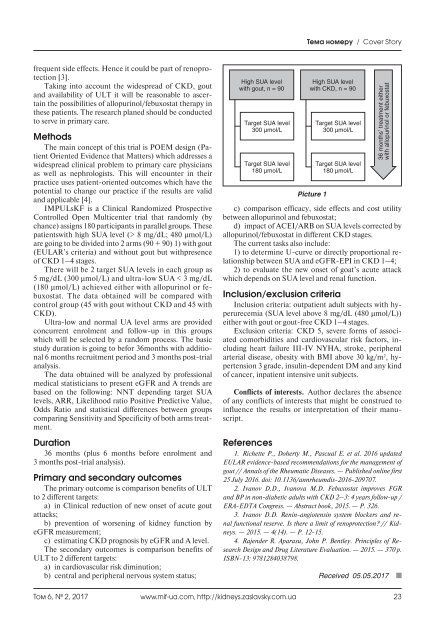Журнал "Почки" №2 (20) 2017
You also want an ePaper? Increase the reach of your titles
YUMPU automatically turns print PDFs into web optimized ePapers that Google loves.
Тема номеру / Cover Story<br />
frequent side effects. Hence it could be part of renoprotection<br />
[3].<br />
Taking into account the widespread of CKD, gout<br />
and availability of ULT it will be reasonable to ascertain<br />
the possibilities of allopurinol/febuxostat therapy in<br />
these patients. The research planed should be conducted<br />
to serve in primary care.<br />
Methods<br />
The main concept of this trial is POEM design (Patient<br />
Oriented Evidence that Matters) which addresses a<br />
widespread clinical problem to primary care physicians<br />
as well as nephrologists. This will encounter in their<br />
practice uses patient-oriented outcomes which have the<br />
potential to change our practice if the results are valid<br />
and applicable [4].<br />
IMPULsKF is a Clinical Randomized Prospective<br />
Controlled Open Multicenter trial that randomly (by<br />
chance) assigns 180 participants in parallel groups. These<br />
patientswith high SUA level (> 8 mg/dL; 480 μmol/L)<br />
are going to be divided into 2 arms (90 + 90) 1) with gout<br />
(EULAR’s criteria) and without gout but withpresence<br />
of CKD 1–4 stages.<br />
There will be 2 target SUA levels in each group as<br />
5 mg/dL (300 μmol/L) and ultra-low SUA < 3 mg/dL<br />
(180 μmol/L) achieved either with allopurinol or febuxostat.<br />
The data obtained will be compared with<br />
control group (45 with gout without CKD and 45 with<br />
CKD).<br />
Ultra-low and normal UA level arms are provided<br />
concurrent enrolment and follow-up in this groups<br />
which will be selected by a random process. The basic<br />
study duration is going to befor 36months with additional<br />
6 months recruitment period and 3 months post-trial<br />
analysis.<br />
The data obtained will be analyzed by professional<br />
medical statisticians to present eGFR and A trends are<br />
based on the following: NNT depending target SUA<br />
levels, ARR, Likelihood ratio Positive Predictive Value,<br />
Odds Ratio and statistical differences between groups<br />
comparing Sensitivity and Specificity of both arms treatment.<br />
Duration<br />
36 months (plus 6 months before enrolment and<br />
3 months post-trial analysis).<br />
Primary and secondary outcomes<br />
The primary outcome is comparison benefits of ULT<br />
to 2 different targets:<br />
а) in Clinical reduction of new onset of acute gout<br />
attacks;<br />
b) prevention of worsening of kidney function by<br />
eGFR measurement;<br />
c) estimating CKD prognosis by eGFR and A level.<br />
The secondary outcomes is comparison benefits of<br />
ULT to 2 different targets:<br />
a) in cardiovascular risk diminution;<br />
b) central and peripheral nervous system status;<br />
High SUA level<br />
with gout, n = 90<br />
Target SUA level<br />
300 μmol/L<br />
Target SUA level<br />
180 μmol/L<br />
High SUA level<br />
with CKD, n = 90<br />
Picture 1<br />
Target SUA level<br />
300 μmol/L<br />
Target SUA level<br />
180 μmol/L<br />
36 months’ treatment either<br />
with allopurinol or febuxostat<br />
c) comparison efficacy, side effects and cost utility<br />
between allopurinol and febuxostat;<br />
d) impact of ACEI/ARB on SUA levels corrected by<br />
allopurinol/febuxostat in different CKD stages.<br />
The current tasks also include:<br />
1) to determine U-curve or directly proportional relationship<br />
between SUA and eGFR-EPI in CKD 1–4;<br />
2) to evaluate the new onset of goat’s acute attack<br />
which depends on SUA level and renal function.<br />
Inclusion/exclusion criteria<br />
Inclusion criteria: outpatient adult subjects with hyperurecemia<br />
(SUA level above 8 mg/dL (480 μmol/L))<br />
either with gout or gout-free CKD 1–4 stages.<br />
Exclusion criteria: CKD 5, severe forms of associated<br />
comorbidities and cardiovascular risk factors, including<br />
heart failure III-IV NYHA, stroke, peripheral<br />
arterial disease, obesity with BMI above 30 kg/m 2 , hypertension<br />
3 grade, insulin-dependent DM and any kind<br />
of cancer, inpatient intensive unit subjects.<br />
Conflicts of interests. Author declares the absence<br />
of any conflicts of interests that might be construed to<br />
influence the results or interpretation of their manuscript.<br />
References<br />
1. Richette P., Doherty M., Pascual E. et al. <strong>20</strong>16 updated<br />
EULAR evidence-based recommendations for the management of<br />
gout // Annals of the Rheumatic Diseases. — Published online first<br />
25 July <strong>20</strong>16. doi: 10.1136/annrheumdis-<strong>20</strong>16-<strong>20</strong>9707.<br />
2. Ivanov D.D., Ivanova M.D. Febuxostat improves FGR<br />
and BP in non-diabetic adults with CKD 2–3: 4 years follow-up /<br />
ERA-EDTA Congress. — Abstract book, <strong>20</strong>15. — P. 326.<br />
3. Ivanov D.D. Renin-angiotensin system blockers and renal<br />
functional reserve. Is there a limit of renoprotection? // Kidneys.<br />
— <strong>20</strong>15. — 4(14). — Р. 12-15.<br />
4. Rajender R. Aparasu, John P. Bentley. Principles of Research<br />
Design and Drug Literature Evaluation. — <strong>20</strong>15. — 370 p.<br />
ISBN-13: 9781284038798.<br />
Received 05.05.<strong>20</strong>17<br />
Том 6, № 2, <strong>20</strong>17<br />
www.mif-ua.com, http://kidneys.zaslavsky.com.ua 23















